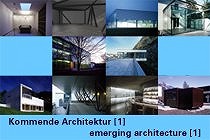
|
Emerging Architecture 1 - Kommende Architektur 1 10 offices Location: Architekturzentrum Wien - Old hall Exhibition: 21 September 2000 - 30 October 2000 Opening Hours: daily 10:00 A.M to 7:00 P.M. Opening: Wednesday 20 September 2000, 7pm Rainer Köberl Weyrerfabrik, Ferdinand Weyrerstrasse 13 A-6020 Innsbruck A U S T R I A Phone +43 (512) 26 10 66 Fax +43 (512) 26 13 04 rainer.koeberl@aon.at Born in 1956 in Innsbruck. 1976 - 1984 Studied architecture at the TU Innsbruck, 1980 - 1981 Study at Technion in Haifa. 1986 - 1992 Assistant at the Institute for Interior Design at the TU Innsbruck with Professor Barth. Since 1993 own studio in Innsbruck, 1993 - 1997 Lecturer of design at the Institute for Urban Development at the TU Innsbruck. Since 1998 Founding member and lecturer at the Academy of Design in Bozen, since 1999 lecturer of design at the Institute for Buildings at the TU Innsbruck. Buildings, Projects (selection): 1986 theater on tour "Treibhaus" 1995 Provisional home DOWAS 1995 Office of the light factory Halotech; all Innsbruck 1996 Old people’s home and nursing home, Feldkirch (Builder’s prize in Vorarlberg, builder’s prize in Austria) 1997 Architectural and urban development concept for "Olympia 2006 Kitzbühel’, together with Dominique Perrault 1999 "Chill Out" provisional home for homeless youths, Innsbruck Rainer Köberl builds spaces to feel good in. But this not about glamour or resort styling — Köberl gives a flair to what is taken for granted, the mood of light, color, sense of touch, tangible elements, acoustics of rooms. He uses materials and shapes in a reduced, unproblematic,directly perceptible form, without aesthetic blind spots, pure yet subtle, unplastered concrete blocks, bare iron, waxed steel, fiber cement, birch plywood; he gets an armchair from the dump and turns it, with the help of Master Hussl, the cabinetmaker, into the short series ST5, which, in aselection of the best of Austria‘s furniture, is judged to be of "timeless quality". Köberl‘s architecture enlivens up the apparently banal, he creates situations which spontaneously and subconsciously correspond, although almost nothing of "design" is immediately evident. As Arno Ritter commented, he creates places "where you would like to sit down and light your Gitanes". Whether in an office, a young people‘s home, a family home or a social center, Köberl‘s use of architectural means is sparing and concentrated. He reduces material, structure and construction so far that it melts into the background,but instead of banality, atmosphere takes over. It is the art of casual rooms - seen far too seldom - which remains distinctive. At the station Chill Out for instance, he uses only four materials: glass, asphalt, fiber cement, plywood, as well as a little metal and the lights from Halotech which he helped design; this could sound like a minimalist trend but is, in fact, the opposite: masterful control of limited resources, a room with almost nothing, which achieves an optimum of true "modernism", consisting of nothing more than the lively luxury of informality. [...] |
 |
|
|
|
Current Preview Permanent Exhibition Emerging Architecture 1 - Kommende Architektur 1 Press Release The 10 offices * Bulant & Wailzer * Peter Ebner * Geiswinkler & Geiswinkler * Kaufmann 96 GmbH * Rainer Köberl * lichtblau . wagner * Marte.Marte * Pichler & Traupmann * Riepl Riepl * Splitterwerk Gallery: Emerging Architecture 1 - Kommende Architektur 1 E-Shop Products: Book: Emerging Architecture 1 / Kommende Architektur 1 DVD: Emerging Architecture 1 - Kommende Architektur 1 Information: Ines Purtauf Tel.: +43 (1) 522 31 15 - 25 Fax: +43 (1) 522 31 17 Email: purtauf@azw.at |
| © Architekturzentrum Wien 2025 |
||



